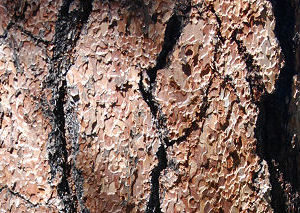Pinus ponderosa is a large coniferous pine (evergreen) tree. The bark helps to distinguish it from other species. Mature to over-mature individuals have yellow to orange-red bark in broad to very broad plates with black crevices. Younger trees have blackish-brown bark, referred to as “blackjacks” by early loggers. Ponderosa pine’s five subspecies, as classified by some botanists, can be identified by their characteristically bright, green needles (contrasting with blue-green needles that distinguish Jeffrey pine). The Pacific subspecies has the longest—19.8 cm or 7.8 in—and most flexible needles in plume-like fascicles of three. The Columbia ponderosa pine has long—12.0–20.5 cm or 4.7–8.1 in—and relatively flexible needles in fascicles of three. The Rocky Mountains subspecies has shorter—9.2–14.4 cm or 3.6–5.7 in—and stout needles growing in scopulate (bushy, tuft-like) fascicles of two or three. The southwestern subspecies has 11.2–19.8 cm or 4.4–7.8 in, stout needles in fascicles of three (averaging 69–89 mm (2.7–3.5 in)). The central High Plains subspecies is characterized by the fewest needles (1.4 per whorl, on average); stout, upright branches at narrow angles from the trunk; and long green needles—14.8–17.9 cm or 5.8–7.0 in—extending farthest along the branch, resembling a fox tail. Needles are widest, stoutest, and fewest (averaging 56–71 mm (2.2–2.8 in)) for the species

